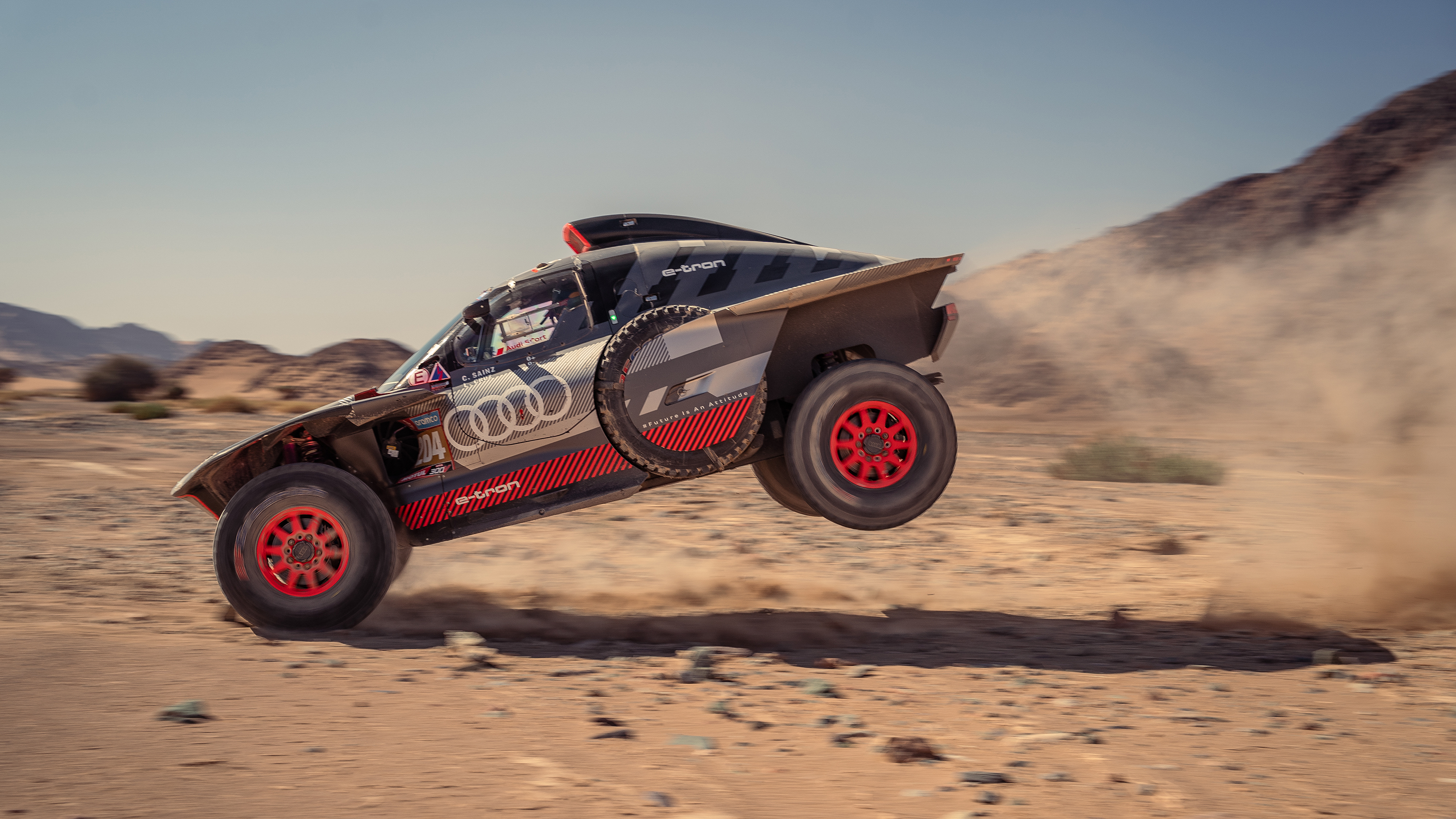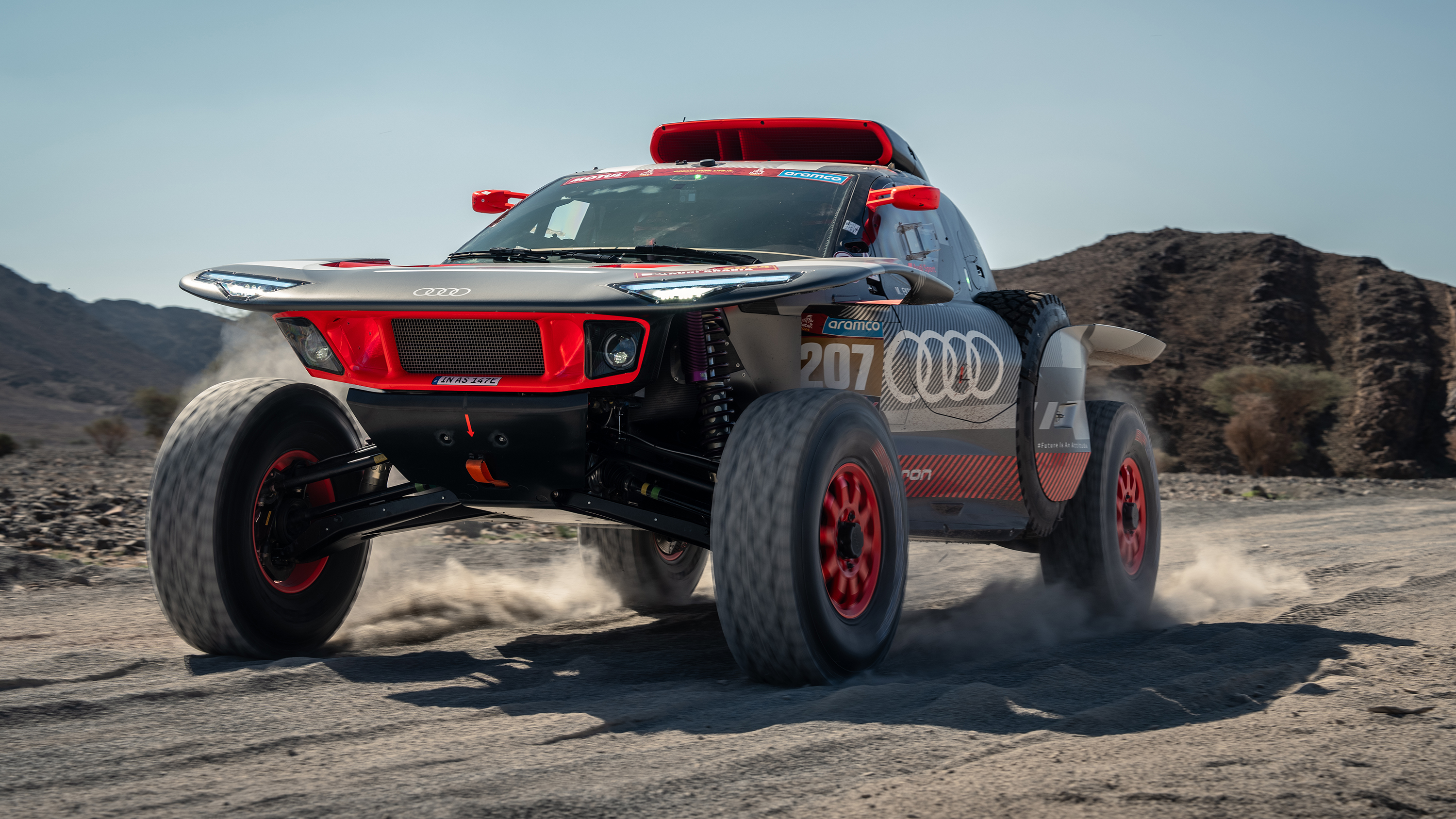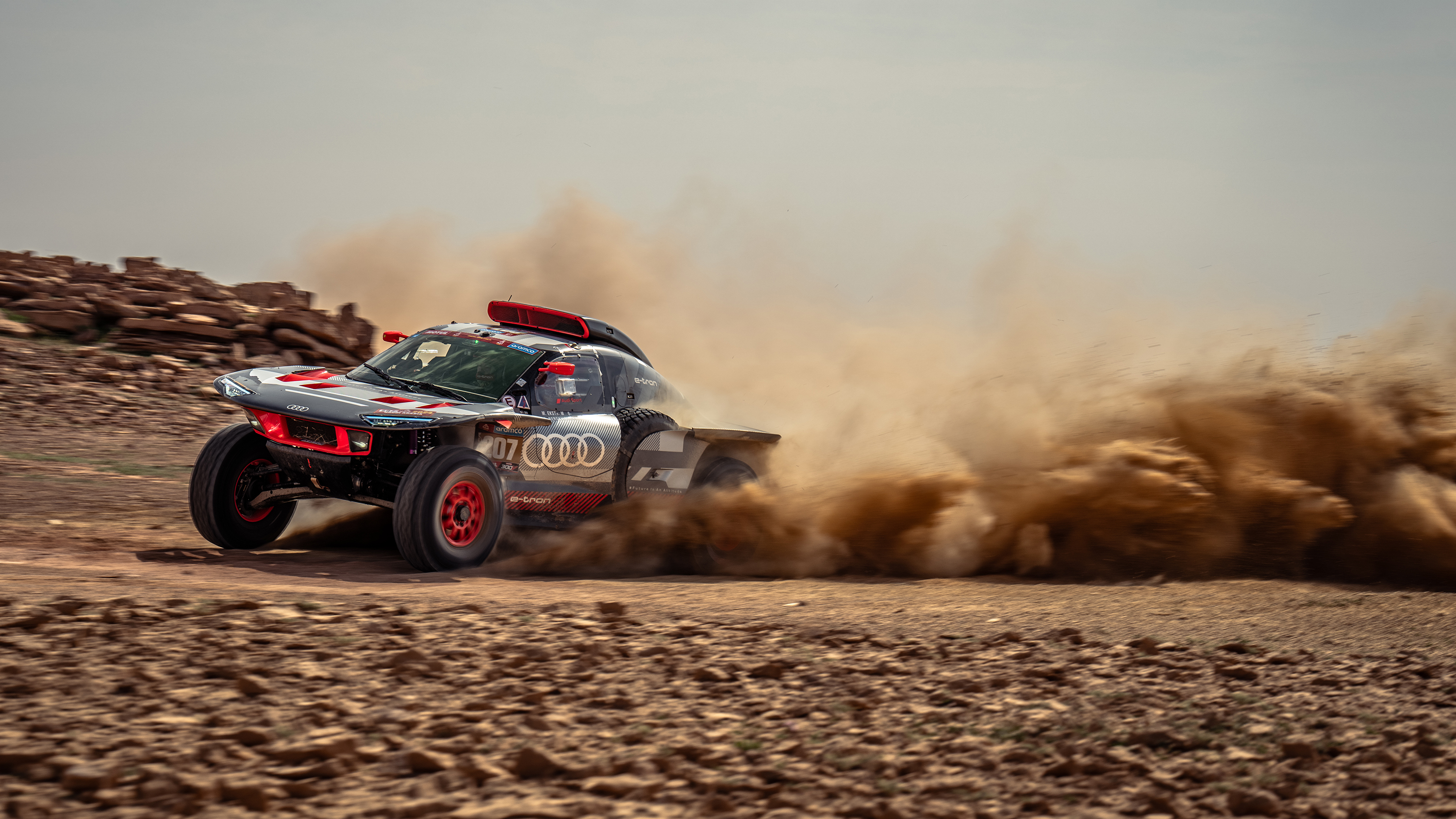
How Audi Won The Iconic Dakar Rally
Three years ago, Audi set itself the seemingly impossible challenge of winning the world’s toughest desert race. Here’s how the famous four rings made motorsport history
Three years ago, Audi had never competed in Rally Raid, the hardcore, Ironman-loving sibling of stage rally, let alone the iconic but gruelling two-week-long Dakar Rally. But Audi, having pushed boundaries and conquered multiple motorsport disciplines throughout its history (including endurance racing and Le Mans, rallying, DTM, IMSA and Formula E) wasn’t afraid of a challenge. In fact, it fancied making one of the toughest races in the world tougher.
The project aimed to be the first car manufacturer to use an electrified drivetrain in combination with an efficient energy converter to compete for overall victory against conventionally powered competitors in the world’s toughest rally. No mean feat, especially as it’s only had three years to bring this brain-melting complex motorsport programme together. From nothing.
And leading up to the 2024 Dakar Rally, Audi’s bosses made it clear that this was its third and final attempt at outright Dakar victory. No pressure, then.
No pressure to win the most punishing event on the motorsport calendar. No pressure to do it on the final opportunity. No pressure of staining its immaculate motorsport record, especially as it’s a manufacturer synonymous with rough-stuff success. Oh, and no pressure to do so in a car concept radically different to anything else that’s ever-scored victory in 45 years of this revered off-road enduro. Talk about a pioneering spirit.
But against all odds, after late nights, heartbreak, injury and tens of thousands of hard-fought racing miles, Audi has completed its mission and the electrified Audi RS Q e-tron has written a new chapter in motorsport history. Thanks to World Rally legend Carlos Sainz and his trusty navigator Lucas Cruz, the pair made history by claiming Audi’s first Dakar win and their fourth triumph as team-mates. Over two torturous weeks, the Spanish duo conquered 5,000 miles across the heart of Saudi Arabia, taking on deserts, climbing near-vertical sand dunes, traversing treacherous rock crawls and having to deal with no fewer than 11 punctures. What a nice, gentle way to break in the New Year.
Granted, Team Audi Sport had a fair idea of what to expect. While this year’s course was 60% new, the RS Q e-tron had taken on the event twice before and collected 28 stage podiums along the way. With that experience under their belt, the Neuburg engineers updated the paradigm-shifting off-road racer for its third attempt as they put outright victory firmly in the crosshairs.
The faultless alternative drive powertrain – which combines championship-winning Formula E motors, a high-voltage battery and a highly efficient energy converter – was carried over from 2023, while the bodywork and suspension were tweaked and weight shed to give the rockstar driver line-up – of Sainz, Mattias Ekström and Stéphane Peterhansel – the ultimate ride. The wheels rims, brake discs and uprights were beefed up to prevent stones penetrating and wreaking havoc. And the two spare tyres, stowed in massive cubbies behind the doors, were made easier to access to speed up roadside repairs.
Although the RS Q e-tron had changed, this year’s running of the toughest rally-raid of started with a sense of déjà vu. Like in 2023, Ekström topped the times on the Prologue (a 17-mile amuse-bouche that allows the fastest crews to pick their starting position for the first proper stage). The double DTM champion picked his way through the Alula sand 23 seconds quicker than the rest. Then Sainz laid down a clear marker the next day. As the Dakar kicked off in anger, with 778 competitors tackling the opening 251 miles of competitive running through volcano passes, he overtook a staggering 47 cars and dealt with three punctures to finish second.
Underlining why the Dakar is quite so formidable, the terrain and challenges were wildly different 24 hours later. For the 292-mile race to Al Duawadimi, rocks made way for a less technical, faster stage. Sainz and Cruz collected a puncture but still set the eighth-best run, and combined with their previous day’s efforts, they moved into the overall lead for the first time. Audi had cause for a double celebration, too. Peterhansel, known as ‘Mr Dakar’ given he’s won the thing 14 times, took the stage victory by some 29 seconds.
Of course, that’s a feat in itself. But for the vastly experienced French racer, it also marked his 50th Dakar stage win while competing in the car class (never mind the other 33 he’s chalked up on motorbikes!). He now ties Finnish icon Ari Vatanen for the four-wheel record. There was also an emotional aside to his achievement. On the 2023 Dakar, Peterhansel and co-driver Édouard Boulanger took a considerable beating. Seven days in, they suffered a particularly brutal landing after a dune. The car was withdrawn and Boulanger airlifted to hospital. He was sidelined from competition for four long months following a broken back. The duo were genuinely unsure whether they would ever again be able to battle it out at the front. Now, they emphatically had their answer.
Mind you, the celebrations couldn’t last too long as Audi then had to tackle one of the Dakar’s infamous Marathon Stages – two days where support vehicles are prohibited, leaving competitors to their own devices to sort any repairs. The biggest headache for Sainz and Cruz came with navigation: co-drivers are only handed the route 20 minutes before they take to the course, so there’s no time to learn lines. Five minutes were lost to a mishap, and they also tagged a crater while picking their way through the dust. The #204 RS Q e-tron narrowly escaped a rollover but had to deploy its onboard hydraulic jack to remedy another puncture. That knocked Sainz to second in the overall standings. Meanwhile, World Rallycross champ Ekström returned to the podium as the fastest Audi driver of the day. The Swede was just 9 seconds short of the stage win as he finished runner-up.
Sainz then really started to flex his decade of Dakar experience. He was only 28th fastest at the end of Stage 5 and dropped another spot to third in the overall order. No need for alarm bells, though. This was another deliberate move. What lay ahead was the new-for-2024 ‘Chrono’ stage. A 48-hour, 340-mile voyage into the renowned Empty Quarter… because the Dakar needed to be even harder. Given the expanse of desert that lay ahead (a sandpit the size of France but home to only 50 people), Audi and Sainz didn’t want to be one of the early runners. So, they had intentionally dropped the pace so a few rivals could slip ahead and lay some tracks in the sand.
That move paid off too. The drivers would have to make do with military-style food rations and sleeping in tents, but Sainz still had the energy to fly out of the gates and take the overall lead. He was fastest to the first gate and kept that speed up for the rest of the run to lead Ekström for an overall Audi 1-2.
Elsewhere, the Dakar was chewing up and spitting out plenty of competitors. Early leader Yazeed Al-Rajhi rolled his truck, 2023 event winner Nasser Al-Attiyah was hobbled by technical issues and Audi’s own Peterhansel was blighted by mechanical gremlins after a hard landing in the dunes. With his own victory charge over, he settled into a new role as the ultimate wingman by shadowing his teammates while carrying tools and spare tyres should disaster ever strike. The rules allow such selfless acts – but spare a thought for the cannibalised car when it and crew are left behind in the desert…
Audi kept hold of first and second come the rally’s halfway point – a welcome rest day by the Saudi capital of Riyadh. The team strategy helped keep Sébastien Loeb, a World Rally legend with nine drivers’ trophies, a good half hour behind. A decent base to work from, but nothing was won yet. The second week was where Audi’s assault came unstuck last year. It’s when Boulanger suffered his injury before Sainz rolled his RS Q e-tron into retirement.
History threatened to repeat itself. Sadly, Ekström and co-driver Emil Bergvist’s campaign was undone by a left-rear suspension issue very early into Stage 7 – made up of canyon passes and dunes. True to his word, Peterhansel spent 40 minutes trying to get his colleagues back underway. That left it to Sainz to keep Audi’s Dakar dream alive.
While overall glory was now out of reach for Ekström and Peterhansel, daily stage wins were still up for grabs. Rather than get bogged down in their misfortune, they bounced back by running 1-2 on day 11. Ekström notched his fourth-ever Dakar stage win on and the seventh for the RS Q e-tron programme. To complete a stellar day, Sainz clocked fourth to retain the overall lead by a healthy 25 minutes.
As Audi crept closer to the spoils, pragmatism took priority. That was fully on show for Stage 9. Soon after Sainz took to the route, he spotted a friendly face. Early starter Peterhansel had pulled over for a couple of minutes so he could then be immediately on hand to provide any support if required. Still, even if help was that close by, Sainz knew better than to chase stage wins. He was happy to turn the speed down just a fraction to cut the risk of a needless shunt.
That had the potential to tee up a showdown between rallying royalty: a hard-charging Loeb closed in as the event revisited Alula. A return to the rally’s starting point also meant the return of the tyre-slashing rocks. Shock, they didn’t show any mercy this time either. Sainz picked up three punctures. Since the RS Q e-tron has space for a brace of spares, Ekström was kind enough to donate one of his as Loeb had to fix a blowout of his own. All told, day 13, which did indeed prove unlucky for some, ended with Sainz’s advantage dropping below 15 minutes.
No one has ever accused the Dakar Rally of being easy. But just to make it that bit tougher for Audi, the penultimate stage happened to be an old foe. The 260-mile dash to Yanbu was used in 2023 and is reckoned to be the hardest section of the lot. Surprise, surprise, it’s dominated by rocks. And although Audi specifically sought out the area while testing for 2024, that shakedown only reinforced it doesn’t really matter whether you’re going slow or fast over this type of surface, punctures are pretty much inevitable.
Sure enough, Sainz picked one up towards the end of the stage. But rather than see his lead come down any further, the Spaniard could rest a little easier. He’d already come across Loeb stricken at the side of the road. While attempting to traverse a tricky rock crawl with no clearly defined path, his car’s wishbone had given up the ghost. That left Sainz with the 12th and final stage to run, and a lead of nigh on 1.5 hours to protect.
The 2024 Dakar Rally concluded with a course along the coast of the Red Sea. Sainz and Cruz did what they needed to do. They brought it home safely to not only claim a much-anticipated Audi victory but in doing so, broke entirely new ground. The RS Q e-tron will always be remembered as the first electrified prototype ever to win the world’s toughest desert rally. Vorsprung durch Technik.
After bowing down to kiss his car on the podium, an understandably emotional Sainz said: “This victory means a lot to me. It’s my fourth victory with the fourth different brand. The team has developed a very special concept with which we are the first in the Dakar Rally. Only Audi was brave enough to take this risk. I’m happy that we’ve made history with it, and in one of the toughest editions of this rally that I have experienced.”
The man himself might think it’s one of the toughest he’s ever known but somehow, on paper, he almost made it look easy. Almost. Sainz took the overall lead twice and was never overtaken after the fifth stage.
“We have written a piece of motorsport history,” added head of Audi Motorsport Rolf Michl. “This sport is also about luck. We lacked that last year. We had an amazing team that never gave up, even when we had setbacks. If you trust your team, they can even achieve the seemingly impossible. We overcame this challenge with long and hard work.
“Our winners Carlos and Lucas are both exceptional. Carlos is not only a top driver, but a legend with a big heart who cares about people, immerses himself in every detail and is never satisfied with himself. It is an honour and a merit that he has competed for our team.”
Three years ago, Audi set itself a seemingly impossible task. But after two Prologue wins, seven stage victories and overall Dakar glory, Audi has added a new strand to its rich motorsport legacy. And it’s not finished breaking new ground yet. New challenges await.
For more Audi performance stories, head this way
*This vehicle shown here is the Rally Dakar vehicle that is not available as a production model. Closed course, professional driver. Do not attempt. The Audi RS Q e-tron combines an electric drivetrain with an energy converter system comprising a TFSI engine and generator.
Featured

More from Top Gear
Trending this week
- Car Review
BMW iX3







